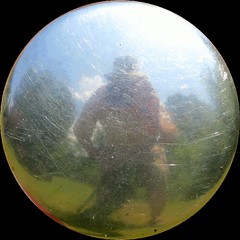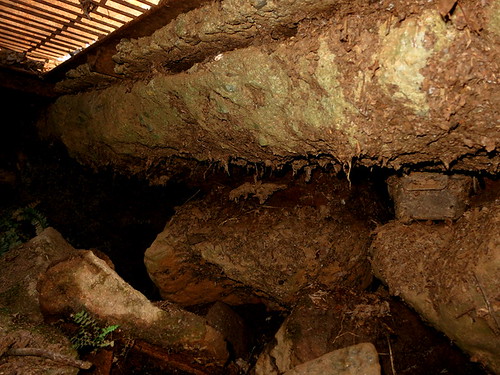A Guest Post by Dave DeBaeremaeker aka debaere

Geocachers carry all sorts of tools with them into the field when they cache: pens, notebooks, mirrors, rope, tweezers and many other things. There is another tool that you may already be carrying, that can be very useful for caching and you may not even realize it. That tool is a camera.
Obviously cameras can be used to take pictures of your adventures, but they also have other uses which you may not be aware of. This post outlines several of those uses.
Muggle Defense
If you are in an area looking around for that elusive cache and a group of muggles comes by it helps to look like you are doing something non-suspicious. A good way is to pull out your camera and look like you are taking photos. If you are asked about what you are doing, you can say that you are participating in a online photo scavenger hunt (like say, this one), and you are trying to capture a photo for one of the items on the scavenger list - say an insect, or a bird, or flowers (pick something that makes sense for the area you are currently in) and this area seemed like a good place to find it. Since you are looking for something to shoot with your camera, you are also free to keep hunting without arousing a great deal of suspicion.
Preserving Information
If you have ever done any multi-caches you have probably come across caches that require you to gather information while out in the field to find the next stage. Whenever I find this information I write it down in my notebook, and I also take a photo of it. It is not uncommon to make mistakes while entering the next stage coordinates into your GPS and head off in the wrong direction. Normally correcting these errors requires back-tracking to the previous stage. If you have a pictures from the previous stage, you can simply consult your camera instead of taking that back-tracking walk of shame. This method has saved me from many back tracks, which in some cases has saved me miles of walking.
This method works for any other type of cache where you have to gather information: virtuals, earth caches, and puzzle caches. Nothing is worse than getting back to your computer to log a virtual, only to realize that you can't remember the answer to the questions you need to log it. Taking a photo means all the information you need is sitting right there on your camera.
Pro tip: If you have an Android phone and use Google Plus, use your camera phone to take these sorts of photos, even if you have a better camera that you normally use (photo quality is not an issue, as long as you can read the info). Android phones will automatically upload pictures to Google Plus, so these images will be waiting for you when you get back to your computer - this saves having to locate that USB cable (which is never in the place you think it is) to upload photos from your camera to your computer, just to log your caches.
Another pro tip: If you find yourself at a trail head with a map posted in an information booth, snap a picture of that map. I would always recommend that you carry a paper map with you if possible, but if you don't have one, snapping that pic of the posted map means you always have one on your camera.
Recon By Photography
One of my favourite things to use my camera for in the field is to do reconnaissance of those hard to reach places where danger might be lurking - dark holes in trees (or pipes), under sewer grates or low walls, or any place where you don't want to stick your hands in case an animal is hiding, waiting to strike. In these cases I use my camera to take photos of the area, then look at the pictures using the cameras view screen to see if I can spot anything.
I recently used this method to spot a cache in a storm drain. The drain itself was a grate 2' by 6', and the cache was somewhere underneath it, tucked safely under the concrete walkway. There was no way for me to see under the concrete, so my only way to locate the cache was to probe blindly with my bare hands, or use recon by photography (I chose the second option). I reached down with the camera and blindly took 4 shots. When I previewed the images I knew two important things. a) there were no animals (especially poisonous snakes) waiting for me, and b) I knew where the cache was. Once I had that information I felt safe blindly reaching my hand down and I quickly had the cache in hand.
This is one of the recon pictures I took. See if you can spot the cache:

So, as you can see, your camera can be a valuable tool in any cachers toolbox. Not only can it be used to record precious memories, it can also be used to record valuable information, or even see into places that you can't see yourself.
To use these tips it doesn't matter what camera you have. Smart phone camera will work just as well as the fanciest DSLr. I hope this post will give you a few more tools in your toolbox to help you out the next time you hit the field.
To read more posts by Dave, check out his blog at Only Googlebot Reads This Blog

No comments yet.